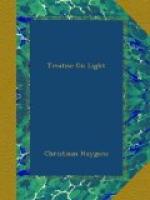Now if light requires time, for example one hour, to traverse the space which is between the Earth and the Moon, it will follow that the Earth having arrived at B, the shadow which it casts, or the interruption of the light, will not yet have arrived at the point C, but will only arrive there an hour after. It will then be one hour after, reckoning from the moment when the Earth was at B, that the Moon, arriving at C, will be obscured: but this obscuration or interruption of the light will not reach the Earth till after another hour. Let us suppose that the Earth in these two hours will have arrived at E. The Earth then, being at E, will see the Eclipsed Moon at C, which it left an hour before, and at the same time will see the sun at A. For it being immovable, as I suppose with Copernicus, and the light moving always in straight lines, it must always appear where it is. But one has always observed, we are told, that the eclipsed Moon appears at the point of the Ecliptic opposite to the Sun; and yet here it would appear in arrear of that point by an amount equal to the angle gec, the supplement of AEC. This, however, is contrary to experience, since the angle gec would be very sensible, and about 33 degrees. Now according to our computation, which is given in the Treatise on the causes of the phenomena of Saturn, the distance Ba between the Earth and the Sun is about twelve thousand diameters of the Earth, and hence four hundred times greater than bc the distance of the Moon, which is 30 diameters. Then the angle ECB will be nearly four hundred times greater than Bae, which is five minutes; namely, the path which the earth travels in two hours along its orbit; and thus the angle BCE will be nearly 33 degrees; and likewise the angle CEG, which is greater by five minutes.
But it must be noted that the speed of light in this argument has been assumed such that it takes a time of one hour to make the passage from here to the Moon. If one supposes that for this it requires only one minute of time, then it is manifest that the angle CEG will only be 33 minutes; and if it requires only ten seconds of time, the angle will be less than six minutes. And then it will not be easy to perceive anything of it in observations of the Eclipse; nor, consequently, will it be permissible to deduce from it that the movement of light is instantaneous.
It is true that we are here supposing a strange velocity that would be a hundred thousand times greater than that of Sound. For Sound, according to what I have observed, travels about 180 Toises in the time of one Second, or in about one beat of the pulse. But this supposition ought not to seem to be an impossibility; since it is not a question of the transport of a body with so great a speed, but of a successive movement which is passed on from some bodies to others. I have then made no difficulty, in meditating on these things, in supposing that the emanation of light is




